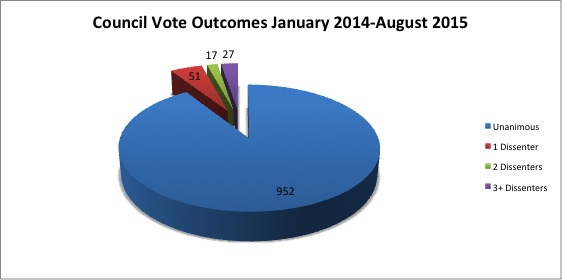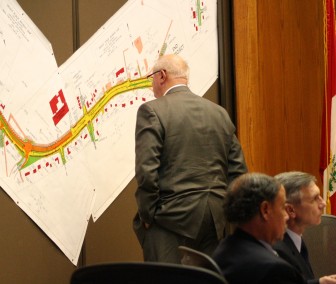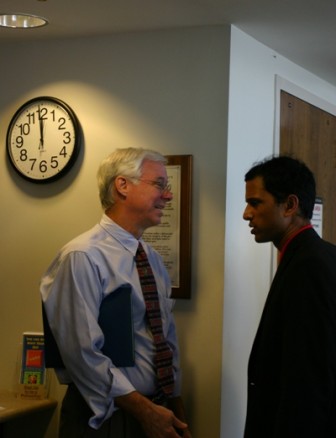Of the 1,047* times a vote has come before city council since January 2014, there were only 95 instances in which the vote was not unanimous.
This accounts for around 9 percent of the total votes held.

It would be disingenuous to imply this means council is largely in lockstep with one another when it comes to major issues facing the city, such as the balance between growth and development and the preservation of existing neighborhoods.
The majority of the votes cast by council are for procedural matters; contract awards, text-change clarifications, board appointees, etc. A vote against the grain on these matters would not serve even a nominal purpose.
While the election itself is nonpartisan, the eight-member body, which includes seven councilors and Mayor Nancy McFarlane, is largely comprised of Democrats. McFarlane is a registered Independent, although she was endorsed this year as in years past by the Wake County Democratic Party.
Longtime councilor John Odom and first-term councilor Wayne Maiorano, who will not be seeking re-election, are the only Republicans.

Councilor John Odom was the lone voice of dissent more than any of his colleagues
From a period ranging between January 2014 and August 4, 2015, Odom was the sole vote against a majority decision 15 separate times. These cases ranged from the approval of a contract on April 15, 2014 for the city’s art plan to a text change regarding fences and walls on April 21, 2015.
There were 19 votes during that time period in which Odom was against the majority but was joined by other councilors. Maiorano voted with Odom against the majority nine times, and councilor Eugene Weeks voted with Odom seven times. The only member who never joined Odom in a dissenting vote was McFarlane.
Maiorano himself was the lone voice of dissent in only two cases.

Russ Stephenson was second only to John Odom when it came to being the lone dissenting vote
After Odom, the councilor with the highest number of lone dissenting votes was Russ Stephenson, who went it alone on eight separate votes. The majority of these cases dealt either with specific zoning cases or with building and code regulations in general.
Councilor Thomas Crowder sided with Stephenson’s dissent three times, and Councilor Kay Crowder later sided with Stephenson five times. Every other member of the council sided with Stephenson’s dissenting vote in at least one instance over the time period stated above.
Each member of the voting body at one point was the lone voice of dissent, although for councilorMary Ann Baldwin, once was apparently enough. Baldwin was the only one to vote against a text change for home rental services proposed in a July 2015 meeting.
Councilor Bonner Gaylord was, like Maiorano, the lone vote in only two cases, one when he voted against a contract for safelight traffic camera systems, and the other when he voted on a fire station relocation.
Of the 95 cases in which there was dissent, only around 11 were split more or less evenly, which included five 4-4 votes, three votes of 4-3 and three votes of 4-2. In six of those cases, the other councilors were either absent from the meeting or excused from voting.
Four of the 4-4 votes dealt with parks projects, and specifically Horseshoe Farm and the proposed Whitewater Park, while the other one involved a fence on Rock Creek Drive.
51 of the cases saw only one dissenting vote, which is around 53 percent of the total number non-unanimous votes. Extrapolating, this means that only four percent of the total votes held by council were opposed by more than one councilor.
No matter how the election shakes out, these numbers are not likely to see a significant shift. A new councilor may steal Odom’s lone-voice-of-dissent thunder, but it would still only be in a small minority of overall cases and not move the needle much when it comes to the percentage of unanimous votes.
*This number of 1,047 was derived through an analysis of council meeting minute archives for a period dating between January 7, 2014 and August 4, 2015. Many of these votes were procedural, and on matters in which it which there is almost zero likelihood of a conflict of interest. It is likely some votes were missed, or over-counted, so we do not present it as an exact number, but rather a close approximation.
If you would like a copy of the spreadsheet(s) in which this data is compiled, please email editor@raleighpublicrecord.org.
